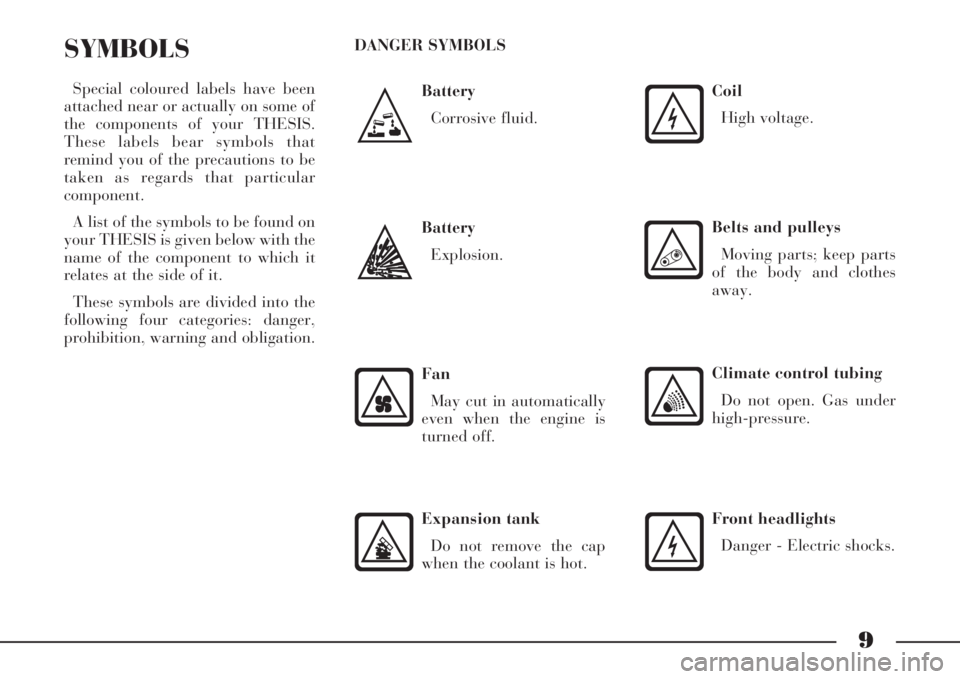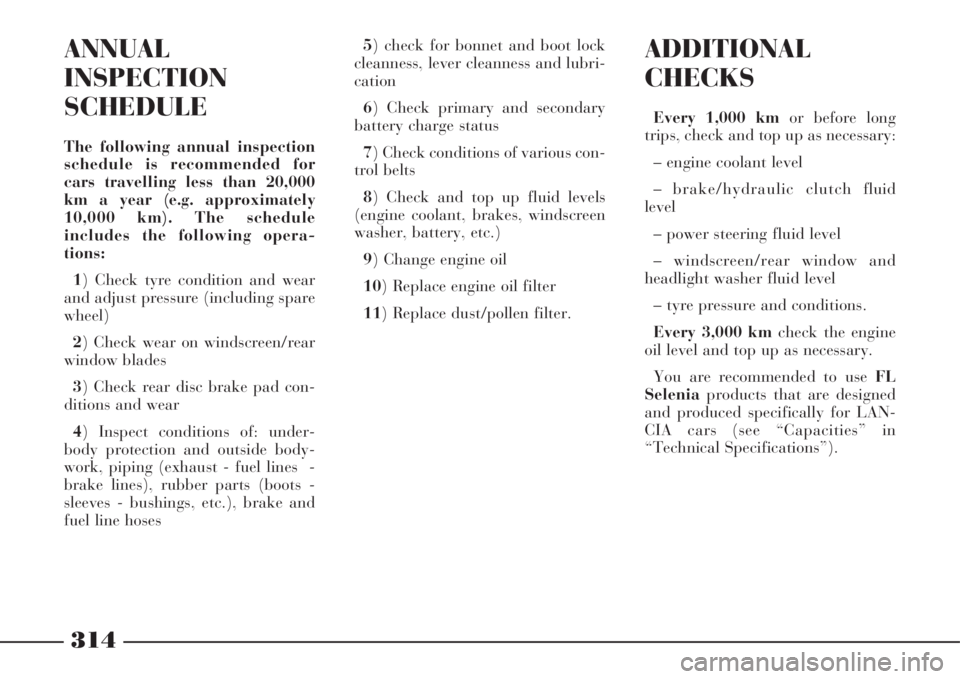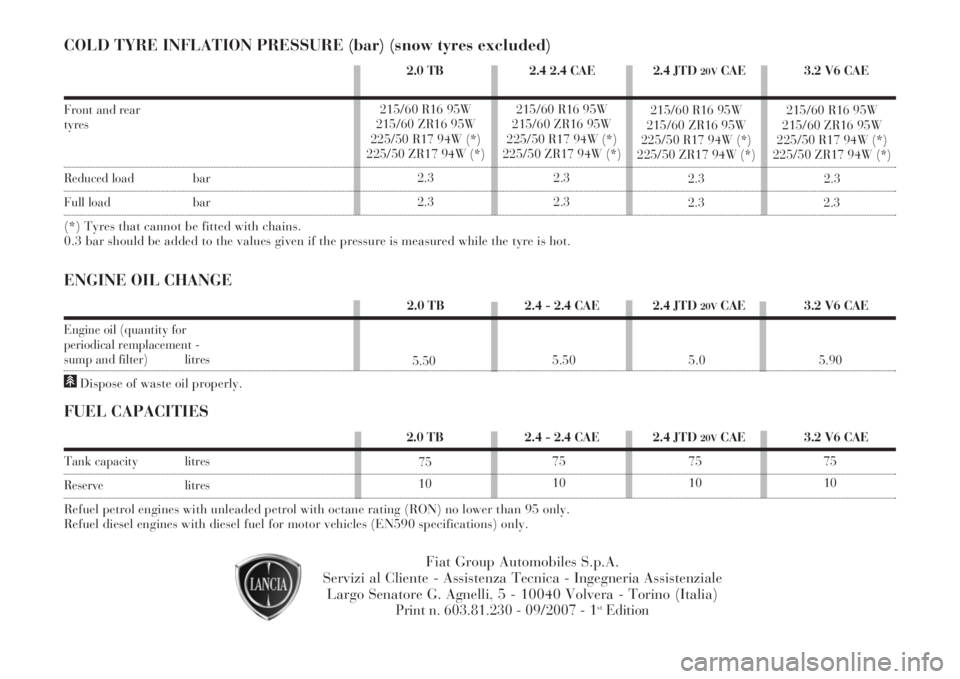oil pressure Lancia Thesis 2008 Owner handbook (in English)
[x] Cancel search | Manufacturer: LANCIA, Model Year: 2008, Model line: Thesis, Model: Lancia Thesis 2008Pages: 386, PDF Size: 4.96 MB
Page 10 of 386

9
Battery
Corrosive fluid.
SYMBOLS
Special coloured labels have been
attached near or actually on some of
the components of your THESIS.
These labels bear symbols that
remind you of the precautions to be
taken as regards that particular
component.
A list of the symbols to be found on
your THESIS is given below with the
name of the component to which it
relates at the side of it.
These symbols are divided into the
following four categories: danger,
prohibition, warning and obligation.DANGER SYMBOLS
Battery
Explosion.
Fan
May cut in automatically
even when the engine is
turned off.
Expansion tank
Do not remove the cap
when the coolant is hot.
Coil
High voltage.
Belts and pulleys
Moving parts; keep parts
of the body and clothes
away.
Climate control tubing
Do not open. Gas under
high-pressure.
Front headlights
Danger - Electric shocks.
Page 136 of 386

135
Engine oil pressure
Warning light/symbol
v
èv
Message
INSUFFICIENT
ENGINE OIL
PRESSURE
SWITCH OFF ENGINE,
DO NOT PROCEED
ENGINE OIL PRESSURE
SENSOR FAULT
GO TO DEALERMeaning of the message
Engine oil pressure is below
the standard value
Engine oil pressure
sensor failureAction
Turn the engine off and contact
aLancia Dealership
IMPORTANTIf engine has been
taxed, when running it idle this
message can appear on the dis-
play but it should go out when
slightly accelerating
Contact a Lancia Dealership
Low battery charge
Warning light/symbol
w
Message
ALTERNATOR FAULT
GO TO
DEALER SLOWLYMeaning of the message
Current generator
failure resulting in
poor car battery
chargeAction
Drive slowly to a Lancia
Dealership
Page 228 of 386

227
BOOT
The boot can be opened both from
the outside and the inside of the car.
IMPORTANTFaulty closing of the
boot is signalled by the lighting of
the relevant symbol on the multi-
function display, together with mes-
sage “BOOT OPEN”With the battery flat, or
after the interruption of
one of the protection
fuses, or if you want to disconnect
a loaded battery (e.g. for a car
stop period), before opening the
luggage compartment bonnet
carefully read and comply with
the instructions contained in the
paragraph “If battery is to be dis-
connected” in the chapter “In an
emergency”.
OPENING FROM THE INSIDE
Boot tailgate is opened electrically.
It can be opened only when the igni-
tion key is at MARand the car is
stopped, or for 3 minutes after turn-
ing the key to STOPwithout open-
ing or closing a door.
To open the boot, press button A
(fig. 192), placed on the central con-
sole, as follows:
– a short pressure of the button will
release the boot lock– a prolonged pressure of the but-
ton will release the lock and open
the boot.
Boot lifting is facilitated by the
action of gas dampers.
The dampers are cali-
brated so as to ensure
correct lifting of the boot
tailgate with the weights estab-
lished by the manufacturer.
Addition of extra equipment (e.g.
spoiler, etc.) can adversely affect
operation and safety of use.
fig. 192
L0A0167b
Page 256 of 386

255
SAFE DRIVING
In designing THESIS, LANCIA has
made every effort to come up with a
car able to provide driver and pas-
senger with top-class levels of safety.
Nevertheless it is always the behav-
iour of the person at the wheel that
determines road safety.
Below you will find some simple
tips to help you travel in safety
under different conditions. You will
no doubt be familiar with many of
them already, but it will be useful to
read them all carefully.
BEFORE GETTING BEHIND
THE WHEEL
– Make sure all lights, including
the headlights, are working proper-
ly.
– Adjust the position of the seats,
steering wheel, driving and door
mirrors properly for the best driving
position.
– Carefully adjust the head
restraints so that the back of the
head and not the nape of the neck is
supported.Make sure that nothing (mats etc.)
gets in the way of the pedals when
they are pushed down.
– Make sure that any child
restraint systems (child seats, carri-
ers etc.) are properly fixed on the
rear seat.
– Place any objects in the boot in
such a way that they cannot be
thrown forwards in the event of an
accident.
– Do not eat a heavy meal before
travelling. Light eating will help
keep your reflexes prompt. Above
all, do not have anything alcoholic to
drink.
Periodically, remember to check:
– tyre pressure and conditions;
– engine oil level;
– coolant level and cooling system
conditions;
– brake fluid level;
– power steering fluid level;
– windscreen washer fluid level. WHEN TRAVELLING
– The first rule of safe driving is
prudence.
– Prudence also means putting
yourself into a position where you
can predict wrong or imprudent
behaviour from other drivers.
– Stick closely to the rules of the
road in the particular country where
the vehicle is being driven and,
above all, do not exceed speed limits.
– Ensure that, besides yourself, all
the other passengers in the vehicle
have their seat belts fastened, that
children are sitting in the appropri-
ate child seats and any animals in
the car are placed in suitable com-
partments.
– You should be physically fit and
mentally alert before setting out on
long journeys.
Page 270 of 386

269
USING THE CAR AGAIN
Before using the car again after a
prolonged period of inactivity, the
following operations are recom-
mended:
– Do not dry-dust the car body.
– Check for fluid leaks (oil, brake
and clutch fluid, engine coolant
etc.).
– Change engine oil and filter.
– Check the level of:
– brake and clutch fluid
– engine coolant.
– Check the air cleaner and change
it, if required.
– Check the tyre pressure and the
tyres for signs of damage, cuts or
cracks. If this is the case, have them
replaced.
– Check the engine belt conditions.STORING THE CAR
The following precautions should
be taken if the car will not be used
for several months:
– Park the car in covered, dry and
if possible well-ventilated premises.
– Engage a gear.
– If the car is parked on flat
ground, disengage the electric park-
ing brake as described in the rele-
vant paragraph.
– Clean and protect the painted
parts using protective wax.
– Sprinkle talcum powder on the
rubber windscreen and rear window
wiper blades and lift them off the
glass.
– Slightly open the windows.
– Inflate the tyres to 0.5 bar above
the normal specified pressure, lean
them on wood boards, if possible
and check it at intervals.– Do not switch the electronic
alarm system on.
– Remove the negative cable (-)
from the battery terminal and check
the battery charge. This check
should be performed every month if
the car is to be stored for long peri-
ods. Recharge the battery if it falls
below 12.5V.
IMPORTANTBefore opening the
luggage compartment bonnet to dis-
connect the battery, carefully read
and comply with instructions con-
tained in the paragraph “If battery is
to be disconnected” in the chapter
“In an emergency”.
– Do not drain the engine cooling
system.
– Cover the car with a cloth or per-
forated plastic sheet. Do not use
sheets of non-perforated plastic as
they do not allow moisture on the
body to evaporate.
Page 315 of 386

314
ADDITIONAL
CHECKS
Every 1,000 kmor before long
trips, check and top up as necessary:
– engine coolant level
– brake/hydraulic clutch fluid
level
– power steering fluid level
– windscreen/rear window and
headlight washer fluid level
– tyre pressure and conditions.
Every 3,000 kmcheck the engine
oil level and top up as necessary.
You are recommended to use FL
Seleniaproducts that are designed
and produced specifically for LAN-
CIA cars (see “Capacities” in
“Technical Specifications”).
ANNUAL
INSPECTION
SCHEDULE
The following annual inspection
schedule is recommended for
cars travelling less than 20,000
km a year (e.g. approximately
10,000 km). The schedule
includes the following opera-
tions:
1) Check tyre condition and wear
and adjust pressure (including spare
wheel)
2) Check wear on windscreen/rear
window blades
3) Check rear disc brake pad con-
ditions and wear
4) Inspect conditions of: under-
body protection and outside body-
work, piping (exhaust - fuel lines -
brake lines), rubber parts (boots -
sleeves - bushings, etc.), brake and
fuel line hoses5) check for bonnet and boot lock
cleanness, lever cleanness and lubri-
cation
6) Check primary and secondary
battery charge status
7) Check conditions of various con-
trol belts
8) Check and top up fluid levels
(engine coolant, brakes, windscreen
washer, battery, etc.)
9) Change engine oil
10) Replace engine oil filter
11) Replace dust/pollen filter.
Page 385 of 386

Fiat Group Automobiles S.p.A.
Servizi al Cliente - Assistenza Tecnica - Ingegneria Assistenziale
Largo Senatore G. Agnelli, 5 - 10040 Volvera - Torino (Italia)
Print n. 603.81.230 - 09/2007 - 1stEdition
COLD TYRE INFLATION PRESSURE (bar) (snow tyres excluded)
ENGINE OIL CHANGE
5.505.50 5.0
FUEL CAPACITIES
5.90
75
1075
1075
1075
10 215/60 R16 95W
215/60 ZR16 95W
225/50 R17 94W (*)
225/50 ZR17 94W (*)
2.3
2.3 215/60 R16 95W
215/60 ZR16 95W
225/50 R17 94W (*)
225/50 ZR17 94W (*)
2.3
2.3 215/60 R16 95W
215/60 ZR16 95W
225/50 R17 94W (*)
225/50 ZR17 94W (*)
2.3
2.3215/60 R16 95W
215/60 ZR16 95W
225/50 R17 94W (*)
225/50 ZR17 94W (*)
2.3
2.3
2.0 TB 2.4 2.4 CAE 2.4 JTD 20VCAE 3.2 V6 CAE
Front and rear
tyres
Reduced load bar
Full load bar
(*) Tyres that cannot be fitted with chains.
0.3 bar should be added to the values given if the pressure is measured while the tyre is hot.
2.0 TB 2.4 - 2.4 CAE 2.4 JTD 20VCAE 3.2 V6 CAE
Engine oil (quantity for
periodical remplacement -
sump and filter) litres
#Dispose of waste oil properly.
2.0 TB 2.4 - 2.4 CAE 2.4 JTD 20VCAE 3.2 V6 CAE
Tank capacity litres
Reserve litres
Refuel petrol engines with unleaded petrol with octane rating (RON) no lower than 95 only.
Refuel diesel engines with diesel fuel for motor vehicles (EN590 specifications) only.